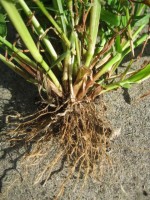 Most of the plants in our garden have roots. We take the roots for granted and usually don’t consider them an important visual feature of our garden but they are very important to our plants and we have to keep them happy or they won’t supply the plant with water and nutrients, and won’t anchor the plants in their place in the border. So we really have to love, cherish and understand roots for the sake of our plants. Actually, they are rather interesting, too. Perhaps you might think that roots are the structures that grow underground, but not all roots do. For example, the knees of bald cypress, or the trunk of a strangler fig are actually roots. Moss and liverworts have absorbing structures that anchor them in the ground but they aren’t roots either even though they look like them. Mistletoe and some orchids have roots that live in the air with no soil at all around them. On the other hand iris and ferns have structures that lie half buried in the soil that look like roots but are actually rhizomes (horizontal stems). Identifying a root is not always easy. Just for fun, decide which of the following are roots (hint: there is more than one root in the list).
Most of the plants in our garden have roots. We take the roots for granted and usually don’t consider them an important visual feature of our garden but they are very important to our plants and we have to keep them happy or they won’t supply the plant with water and nutrients, and won’t anchor the plants in their place in the border. So we really have to love, cherish and understand roots for the sake of our plants. Actually, they are rather interesting, too. Perhaps you might think that roots are the structures that grow underground, but not all roots do. For example, the knees of bald cypress, or the trunk of a strangler fig are actually roots. Moss and liverworts have absorbing structures that anchor them in the ground but they aren’t roots either even though they look like them. Mistletoe and some orchids have roots that live in the air with no soil at all around them. On the other hand iris and ferns have structures that lie half buried in the soil that look like roots but are actually rhizomes (horizontal stems). Identifying a root is not always easy. Just for fun, decide which of the following are roots (hint: there is more than one root in the list).
 Beet
Beet
 Carrot
Carrot
 Onion
Onion
 Sweet potato
Sweet potato
 White potato
White potato
 Turnip
Turnip
If you identified beet, carrot, sweet potato and turnip as roots you are right; onions are actually bulbs (compressed stem with modified leaves), and a white potato is a tuber (modified stem).
So, lets take a closer look at what it takes to be considered a true root.
Functions: In general, a true root carries out 4 basic functions:
1. anchor the plant
2. supply physical support to the stems
3. absorb nutrients and water
4. store food and nutrients
Internal Anatomy: True roots…
1. have specialized tissue called xylem and phloem for moving water and nutrients to the stem.
2. tissues arranged around a central core of xylem and include endodermis, pericyle, and epidermis.
3. lack buds, that is do not have specialized cells that will develop into leaves, flowers, cones, or other plant structures.
Development: True roots develop from the basal part of the plant embryo while the stem does not.
Based on these criteria we can explain why some structures are roots and others are not no matter what they look like on the surface or do for the plant. For example, the mosses and liverwort don’t have roots because those root-like structures don’t have specialized tissue (xylem and phloem) and they don’t develop from the basal part of the plant embryo. The rhizomes of a fern, or the tuber of potato that look like roots are considered modified stems because they have buds.
Why is any of this important to a gardener? The more you understand about plants the more information you can absorb as you read gardening magazines or get into specialized fields such as propagation. Roots have characteristics that they don’t share with stems and knowing the specific differences between these plant parts can help you develop solutions to gardening problems.

[…] Botany for Gardeners: The Root-Characteristics and Functions […]